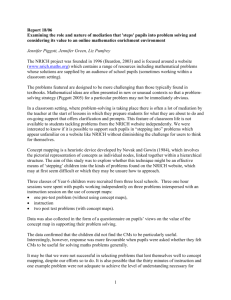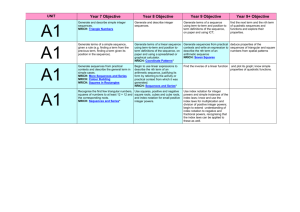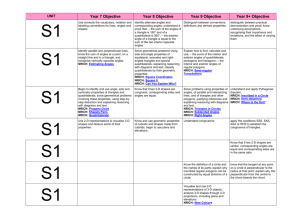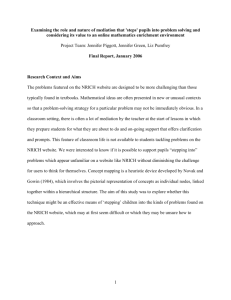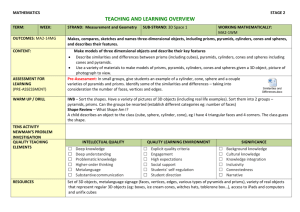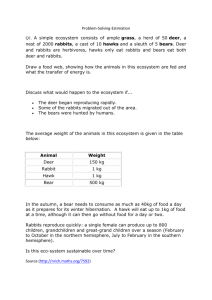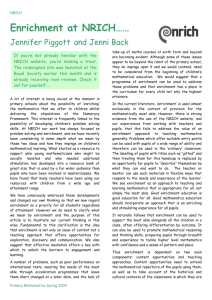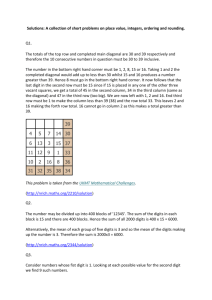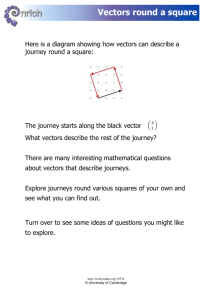Foundation
advertisement
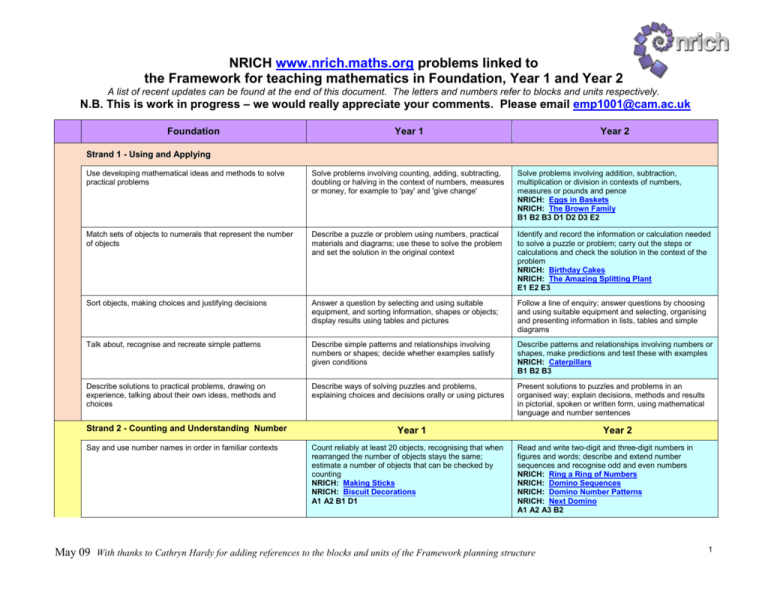
NRICH www.nrich.maths.org problems linked to the Framework for teaching mathematics in Foundation, Year 1 and Year 2 A list of recent updates can be found at the end of this document. The letters and numbers refer to blocks and units respectively. N.B. This is work in progress – we would really appreciate your comments. Please email emp1001@cam.ac.uk Foundation Year 1 Year 2 Strand 1 - Using and Applying Use developing mathematical ideas and methods to solve practical problems Solve problems involving counting, adding, subtracting, doubling or halving in the context of numbers, measures or money, for example to 'pay' and 'give change' Solve problems involving addition, subtraction, multiplication or division in contexts of numbers, measures or pounds and pence NRICH: Eggs in Baskets NRICH: The Brown Family B1 B2 B3 D1 D2 D3 E2 Match sets of objects to numerals that represent the number of objects Describe a puzzle or problem using numbers, practical materials and diagrams; use these to solve the problem and set the solution in the original context Identify and record the information or calculation needed to solve a puzzle or problem; carry out the steps or calculations and check the solution in the context of the problem NRICH: Birthday Cakes NRICH: The Amazing Splitting Plant E1 E2 E3 Sort objects, making choices and justifying decisions Answer a question by selecting and using suitable equipment, and sorting information, shapes or objects; display results using tables and pictures Follow a line of enquiry; answer questions by choosing and using suitable equipment and selecting, organising and presenting information in lists, tables and simple diagrams Talk about, recognise and recreate simple patterns Describe simple patterns and relationships involving numbers or shapes; decide whether examples satisfy given conditions Describe patterns and relationships involving numbers or shapes, make predictions and test these with examples NRICH: Caterpillars B1 B2 B3 Describe solutions to practical problems, drawing on experience, talking about their own ideas, methods and choices Describe ways of solving puzzles and problems, explaining choices and decisions orally or using pictures Present solutions to puzzles and problems in an organised way; explain decisions, methods and results in pictorial, spoken or written form, using mathematical language and number sentences Strand 2 - Counting and Understanding Number Say and use number names in order in familiar contexts Year 1 Count reliably at least 20 objects, recognising that when rearranged the number of objects stays the same; estimate a number of objects that can be checked by counting NRICH: Making Sticks NRICH: Biscuit Decorations A1 A2 B1 D1 Year 2 Read and write two-digit and three-digit numbers in figures and words; describe and extend number sequences and recognise odd and even numbers NRICH: Ring a Ring of Numbers NRICH: Domino Sequences NRICH: Domino Number Patterns NRICH: Next Domino A1 A2 A3 B2 May 09 With thanks to Cathryn Hardy for adding references to the blocks and units of the Framework planning structure 1 Know that numbers identify how many objects are in a set Compare and order numbers, using the related vocabulary; use the equals (equals) sign Count up to 100 objects by grouping them and counting in tens, fives or twos; explain what each digit in a twodigit number represents, including numbers where 0 is a place holder; partition two-digit numbers in different ways, including into multiples of 10 and 1 NRICH: Grouping Goodies A1 A2 A3 Count reliably up to 10 everyday objects Read and write numerals from 0 to 20, then beyond; use knowledge of place value to position these numbers on a number track and number line NRICH: Tug of War NRICH: Writing Digits A1 A2 A3 B1 Order two-digit numbers and position them on a number line; use the greater than (greater than) and less than (less than) signs NRICH: 100 Square Jigsaw A1 A3 Estimate how many objects they can see and check by counting Say the number that is 1 more or less than any given number, and 10 more or less for multiples of 10 Estimate a number of objects; round two-digit numbers to the nearest 10 Count aloud in ones, twos, fives or tens NRICH: Incey Wincey Spider Use the vocabulary of halves and quarters in context Find one half, one quarter and three quarters of shapes and sets of objects NRICH: Halving NRICH: Happy Halving E1 E2 E3 Use language such as 'more' or 'less' to compare two numbers Use ordinal numbers in different contexts Recognise numerals 1 to 9 Strand 3 – Knowing and Using Number Facts Year 1 Year 2 Observe number relationships and patterns in the environment and use these to derive facts Derive and recall all pairs of numbers with a total of 10 and addition facts for totals to at least 5; work out the corresponding subtraction facts NRICH: Cuisenaire Environment NRICH: Domino Sorting NRICH: One Big Triangle B1 B2 B3 Derive and recall all addition and subtraction facts for each number to at least 10, all pairs with totals to 20 and all pairs of multiples of 10 with totals up to 100 NRICH: Weighted Numbers NRICH: Number Balance B1 B2 B3 Find one more or one less than a number from 1 to 10 Count on or back in ones, twos, fives and tens and use this knowledge to derive the multiples of 2, 5 and 10 to the tenth multiple NRICH: Are You Well Balanced? NRICH: Buzzy Bee E1 E2 E3 Understand that halving is the inverse of doubling and derive and recall doubles of all numbers to 20, and the corresponding halves NRICH: The Tomato and the Bean B1 B3 E1 E2 E3 Select two groups of objects to make a given total of objects Recall the doubles of all numbers to at least 10 NRICH: Magic Plant E1 E2 E3 B2 B3 Derive and recall multiplication facts for the 2, 5 and 10 times-tables and the related division facts; Recognize multiples of 2, 5 and 10 NRICH: Clapping Times B1 B2 B3 NRICH: Lots of Lollies E1 E2 E3 May 09 With thanks to Cathryn Hardy for adding references to the blocks and units of the Framework planning structure 2 Use knowledge of number facts and operations to estimate and check answers to calculations Strand 4 – Calculating Year 1 Year 2 Begin to relate addition to combining two groups of objects and subtraction to ‘taking away’ Relate addition to counting on; recognise that addition can be done in any order; use practical and informal written methods to support the addition of a one-digit number or a multiple of 10 to a one-digit or two-digit number NRICH: Number Lines NRICH: Getting the Balance NRICH: Ladybirds in the Garden A1 A2 A3 B3 D2 D3 Add or subtract mentally a one-digit number or a multiple of 10 to or from any two-digit number; use practical and informal written methods to add and subtract two-digit numbers NRICH: Butterfly Flowers NRICH: Number Round Up NRICH: 4 Dom A1 A2 A3 D1 D2 D3 In practical activities and discussion begin to use the vocabulary involved in adding and subtracting Understand subtraction as ‘take away’ and find a ‘difference’ by counting up; use practical and informal written methods to support the subtraction of a one-digit number from a one digit or two-digit number and a multiple of 10 from a two-digit number NRICH: Find the Difference A1 A2 A3 Understand that subtraction is the inverse of addition and vice versa; use this to derive and record related addition and subtraction number sentences NRICH: Secret Number A1 A3 Count repeated groups of the same size Use the vocabulary related to addition and subtraction and symbols to describe and record addition and subtraction number sentences NRICH: 2,4,6,8 A1 A2 A3 B3 E1 E2 E3 Represent repeated addition and arrays as multiplication, and sharing and repeated subtraction (grouping) as division; use practical and informal written methods and related vocabulary to support multiplication and division, including calculations with remainders NRICH: Share Bears E1 E2 E3 Share objects into equal groups and count how many in each group Solve practical problems that involve combining groups of 2, 5 or 10, or sharing into equal groups Use the symbols plus, -, multiplied by, divided by and equals to record and interpret number sentences involving all four operations; calculate the value of an unknown in a number sentence (e.g. square divided by 2 equals 6, 30 – square equals 24) Strand 5 – Understanding Shape Year 1 Year 2 Use familiar objects and common shapes to create and recreate patterns and build models NRICH: Chairs and Tables NRICH: Repeating Patterns Visualise and name common 2-D shapes and 3-D solids and describe their features; use them to make patterns, pictures and models NRICH: Building with Solid Shapes NRICH: A City of Towers B1 B2 B3 Visualise common 2-D shapes and 3-D solids; identify shapes from pictures of them in different positions and orientations; sort, make and describe shapes, referring to their properties NRICH: Matching Triangles B1 B2 B3 NRICH: Complete the Square NRICH: Shadow Play NRICH: Skeleton Shapes NRICH: Let’s Investigate Triangles Use language such as ‘circle’ or ‘bigger’ to describe the shape and size of solids and flat shapes Identify objects that turn about a point (e.g. scissors) or about a line (e.g. a door); recognise and make whole, half and quarter turns NRICH: Turning D2 D3 Identify reflective symmetry in patterns and 2-D shapes and draw lines of symmetry in shapes NRICH: Colouring Triangles B2 May 09 With thanks to Cathryn Hardy for adding references to the blocks and units of the Framework planning structure 3 Use everyday words to describe position NRICH: Coloured Squares Visualise and use everyday language to describe the position of objects and direction and distance when moving them, for example when placing or moving objects on a game board NRICH: 2 Rings D1 D2 D3 Follow and give instructions involving position, direction and movement Recognise and use whole, half and quarter turns, both clockwise and anticlockwise; know that a right angle represents a quarter turn NRICH: Turning Man D2 D3 Strand 6 - Measuring Year 1 Year 2 Use language such as 'greater', 'smaller', 'heavier' or 'lighter' to compare quantities Estimate, measure, weigh and compare objects, choosing and using suitable uniform non-standard or standard units and measuring instruments (e.g. a lever balance, metre stick or measuring jug) NRICH: Sizing Them Up C1 C2 C3 NRICH: Wallpaper D1 D2 D3 Estimate, compare and measure lengths, weights and capacities, choosing and using standard units (m, cm, kg, litre) and suitable measuring instruments NRICH: Little Man C1 C2 C3 D1 D2 D3 Use everyday language related to time; order and sequence familiar events and measure short periods of time NRICH: Snap Use vocabulary related to time; order days of the week and months; read the time to the hour and half hour Read the numbered divisions on a scale, and interpret the divisions between them (e.g. on a scale from 0 to 25 with intervals of 1 shown but only the divisions 0, 5, 10, 15 and 20 numbered); use a ruler to draw and measure lines to the nearest centimetre Use units of time (seconds, minutes, hours, days) and know the relationships between them; read the time to the quarter hour; identify time intervals, including those that cross the hour NRICH: Stop the Clock D1 D2 D3 Strand 7 - Handling Data Year 1 Year 2 Sort familiar objects to identify their similarities and differences Answer a question by recording information in lists and tables; present outcomes using practical resources, pictures, block graphs or pictograms NRICH: Noah C1 C2 C3 Answer a question by collecting and recording data in lists and tables; represent the data as block graphs or pictograms to show results; use ICT to organise and present data NRICH: Ladybird Count C1 C2 C3 Count how many objects share a particular property, presenting results using pictures, drawings or numerals Use diagrams to sort objects into groups according to a given criterion; suggest a different criterion for grouping the same objects NRICH: Sort the Street NRICH: Mixed-up Socks B3 C1 C2 C3 Use lists, tables and diagrams to sort objects; explain choices using appropriate language, including 'not' NRICH: Carroll Diagrams NRICH: What Shape and Colour? C1 C2 C3 Updates in January 2009: Writing Digits, Colouring Triangles, Mixed-up Socks, What Shape and Colour? Updates in February 2009: 4 Dom Updates in March 2009: One Big Triangle, A City of Towers Updates in May 2009: Let’s Investigate Triangles May 09 With thanks to Cathryn Hardy for adding references to the blocks and units of the Framework planning structure 4
